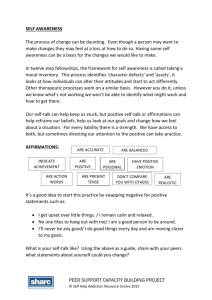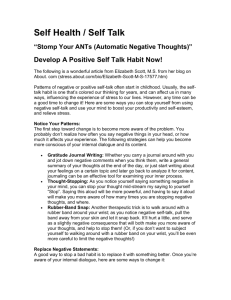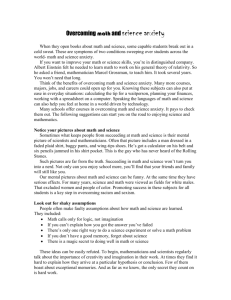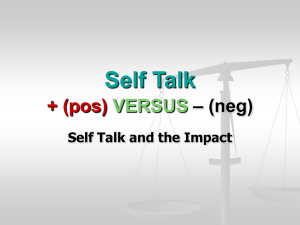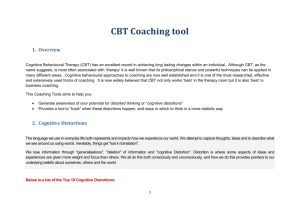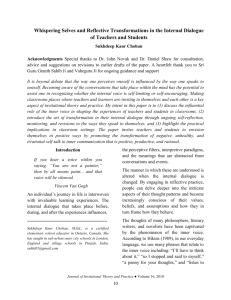The Cognitive Model
advertisement
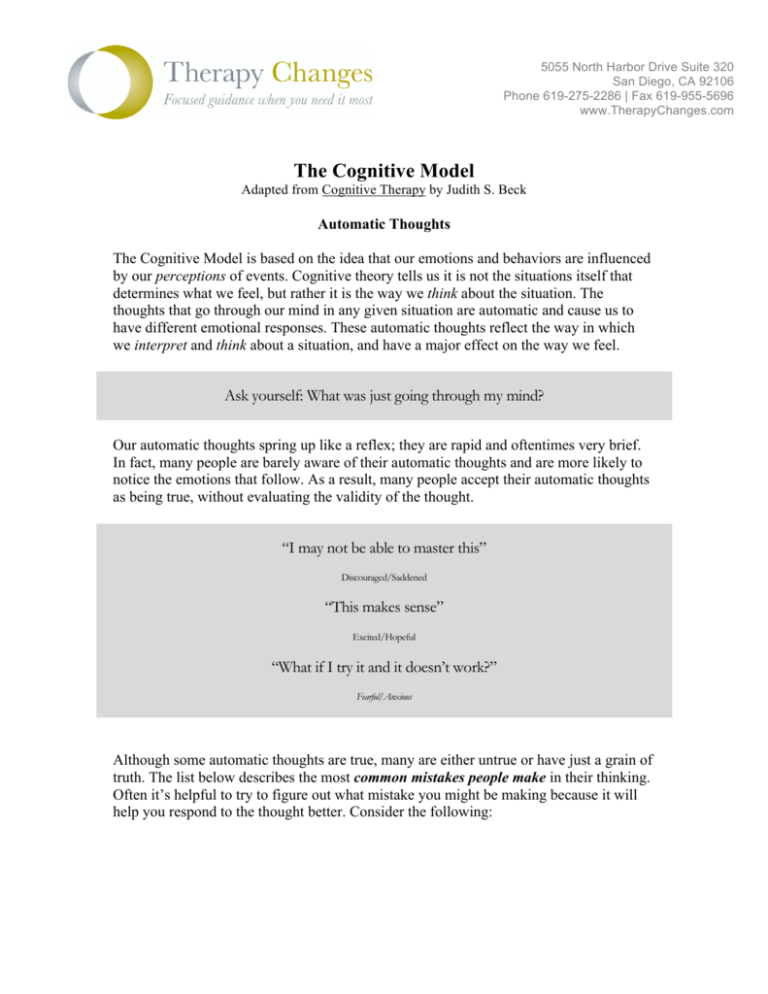
5055 North Harbor Drive Suite 320 San Diego, CA 92106 Phone 619-275-2286 | Fax 619-955-5696 www.TherapyChanges.com The Cognitive Model Adapted from Cognitive Therapy by Judith S. Beck Automatic Thoughts The Cognitive Model is based on the idea that our emotions and behaviors are influenced by our perceptions of events. Cognitive theory tells us it is not the situations itself that determines what we feel, but rather it is the way we think about the situation. The thoughts that go through our mind in any given situation are automatic and cause us to have different emotional responses. These automatic thoughts reflect the way in which we interpret and think about a situation, and have a major effect on the way we feel. Ask yourself: What was just going through my mind? Our automatic thoughts spring up like a reflex; they are rapid and oftentimes very brief. In fact, many people are barely aware of their automatic thoughts and are more likely to notice the emotions that follow. As a result, many people accept their automatic thoughts as being true, without evaluating the validity of the thought. “I may not be able to master this” Discouraged/Saddened “This makes sense” Excited/Hopeful “What if I try it and it doesn’t work?” Fearful/Anxious Although some automatic thoughts are true, many are either untrue or have just a grain of truth. The list below describes the most common mistakes people make in their thinking. Often it’s helpful to try to figure out what mistake you might be making because it will help you respond to the thought better. Consider the following: 5055 North Harbor Drive Suite 320 San Diego, CA 92106 Phone 619-275-2286 | Fax 619-955-5696 www.TherapyChanges.com Typical Mistakes in Thinking: 1. Black-and-white thinking: You view a situation in only two categories instead of a continuum (areas of grey) Example: “If I’m not a total success, I’m a failure” 2. Catastrophizing:: You predict the future negatively without considering other, more likely outcomes. Example: “I’ll be so upset; I won’t be able to function at all.” 3. Disqualifying or discounting the positive: You unreasonably tell yourself that positive experiences, deeds, or qualities do not count. Example: “I did that project well, but that doesn’t mean I’m competent; I just got lucky” 4. Emotional reasoning: You think something must be true because you “feel” (actually believe) it so strongly, ignoring or discounting evidence to the contrary. Example: “I know I do a lot of things okay at work, but I still feel like I’m a failure.” 5. Labeling: You put a fixed, global label on yourself or others without considering that the evidence might more reasonably lead to a less disastrous conclusion. Example: “I’m a loser. He’s no good.” 6. Magnification/Minimization: When you evaluate yourself, another person, or a situation, you unreasonably magnify the negative and/or minimize the positive. Example: “Getting a mediocre evaluation proves how inadequate I am.” Getting high marks doesn’t mean I’m smart.” 7. Mental filter: You pay undue attention to one negative detail instead of seeing the whole picture. Example: “Because I got one low rating on my evaluation [which contained several high ratings] it means I’m doing a lousy job.” 8. Mind reading: You believe you know what others are thinking, failing to consider other, more likely possibilities. Example: “He’s thinking that I don’t know the first thing about the project.” 9. Overgeneralization: You make a sweeping negative conclusion that goes far beyond the current situation. Example: “[Because I felt uncomfortable at the meeting] I don’t have what it takes to make friends.” 10. Personalization: You believe others are behaving negatively because of you, without considering more plausible explanations for their behavior. Example: “The repairman was curt to me because I did something wrong.” 11. “Should” and “Must” Statements: you have a precise, fixed idea of how you or others should behave and you overestimate how bad it is that these expectations are not met. Example: “It’s terrible that I made a mistake. I should always be perfect.” 12. Tunnel Vision: you only see the negative aspects of a situation. Example: “My son’s teacher can’t do anything right. He’s critical and insensitive and lousy at teaching.” 5055 North Harbor Drive Suite 320 San Diego, CA 92106 Phone 619-275-2286 | Fax 619-955-5696 www.TherapyChanges.com Negative Self-Talk Negative self-talk are types of automatic thoughts that are not evaluated for truthfulness. Negative self-talk can be thought of as a series of bad habits. Our negative self-talk is based on beliefs we have about ourselves, our world, and our future. Changing our Negative Self-Talk We are not born with a predisposition to negative self-talk; we learn to think that way. Thus, just as we can replace unhealthy behavioral habits with more positive, healthy habits, we can replace unhealthy thinking with more positive, supportive mental habits. The first step to moving towards changing our thinking is learning to more accurately identify our negative self-talk. Types of Negative Self-Talk Adapted from The Anxiety and Phobia Workbook Not all negative self-talk is the same. Human beings are not only diverse, but complex, and our self-talk reflects our individuality. Below are the four more common types of negative-self talk. However, these types may or may not fit with you to varying degrees. As you read, pay attention to the themes. Remember, only you can say with any certainty what you are telling yourself. 1. The Worrier (promotes Anxiety) The Worrier causes anxiety by imagining the worst-case scenario. It scares you with fantasies of disaster or catastrophe when you imagine confronting something you fear. It also aggravates panic by reacting to physical symptoms associated with anxiety (tight stomach, light headedness, sweaty palms, etc.) The Worrier promotes your fear that what is happening is dangerous or embarrassing. “What if…?” Consider the following characteristics about the Worrier: o Anticipating the worst o Overestimating the odds of something bad or embarrassing happening o Creating grandiose images of potential failure or catastrophe 5055 North Harbor Drive Suite 320 San Diego, CA 92106 Phone 619-275-2286 | Fax 619-955-5696 www.TherapyChanges.com 2. The Critic (promotes Low Self-Esteem) The Critic is constantly judging and evaluating your behavior. It tends to point out flaws and limitations and ignore other positive qualities. It jumps on any mistake you make and reminds you of your failures. The Critic often compares you to others. “That was stupid!” Consider the following characteristics about the Critic: o Putting yourself down o Comparing yourself to others o Focusing on limitations and minimizing accomplishments 3. The Victim (promotes Depression) The Victim feels helpless or hopeless. It tells you that you are not making progress, that your condition is incurable, or that the road is too long and steep for you to have a real chance at recovering. The Victim believes that there is something inherently wrong with you: you are in some ways deprived, defective, or unworthy. The Victim always perceives insurmountable obstacles between you and your goals. “I can’t” / “I’ll never be able to” Consider the following characteristics about the Victim: o No motivation – low physical and mental energy o Feels defeated before starting “What’s the point?” o Does not believe he or she is worthy of change 4. The Perfectionist (promotes Stress) The Perfectionist’s concern is less to put you down like the Critic, but more to push you to do better. It constantly tells you that your efforts are not good enough, that you should be working harder, have everything under control, competent, pleasing, etc. etc. The Perfectionist is intolerable of mistakes or setbacks. It has a tendency to try to convince you that your self-worth is dependent on externals such as vocational achievement, money and status, acceptance by others, being loved, or your consistent ability to be pleasing and nice to others regardless of what they do. “I always need to be perfect” Consider the following characteristics about the Perfectionist: o Oftentimes puts other’s needs above your own 5055 North Harbor Drive Suite 320 San Diego, CA 92106 Phone 619-275-2286 | Fax 619-955-5696 www.TherapyChanges.com o o o o Prone to burnout Pushes you to stress In the pursuit of unrealistic goals Intolerable of mistakes or setbacks Thought Record A thought record is an organized way of responding to thoughts that are distressing you. Because life happens outside of the therapy room, the thought record is a useful tool to gather information from your life. Similar to how a scientist would gather data; this is a way for us to understand more thoroughly the situations and associated automatic thoughts that happen day-to-day. At first this method may feel unfamiliar, and it may take some practice to get really good at it. It is helpful to concentrate on one column at a time until you feel comfortable. Using your Thought Record: Directions: When you notice your mood changing, ask yourself, “What’s going through my mind right now?” and as soon as possible jot down the following information: Date/Time and Location Example: Thursday, 6pm, at home Automatic Thought What went through your mind? Emotion What emotion was associated with the automatic thought? Situation What was the problematic situation? Meaning of the Automatic Thought If this thought were true, what would it mean to you? Behavior What did you do [or what happened] then?
